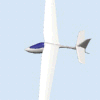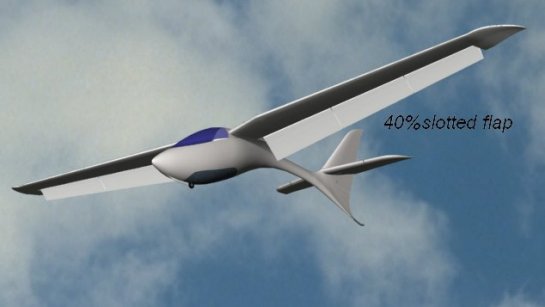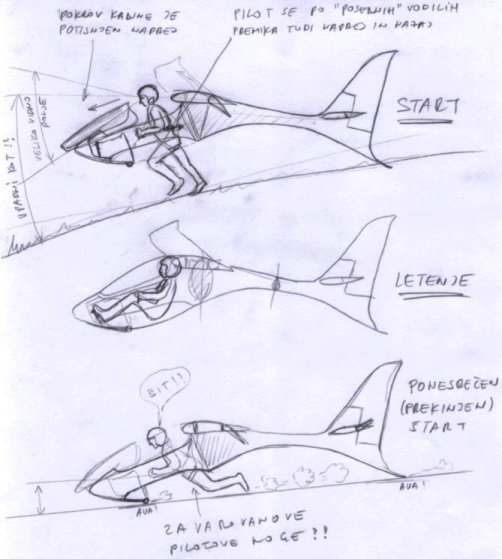GUIDELINES THAT I PICK UP FOR DESIGNING THE FOOT LAUNCHABLE
MICROLIGHT SAILPLANE
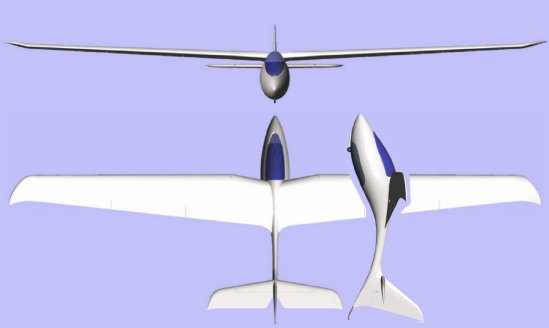
PERFORMANCE GOALS:
- To achieve similar or better performance than
modern flex wings hang gliders (topless – competition type) L/D around 15
to 20 and sink rate smaller than1m/s
- Ability to safe take off and landing on ordinary
foot launch sites in our country
- And most of all, having fun building it and
flying it !!!
HANDLING GOALS:
- Easy assembly /deassembly and transport on top
of car (using apropriate modified rack)
- Easy manouvering during entering the cockpit and
attaching the pilot harness.
- Easy moving with glider to the launch place even
in wind (lightweight and small enough !)
- No need to take care of the angle of attack
during early phase of take off (acceleration phase)
- Light controls and electrically (threaded rod)
driven flaps
- Controls for yaw with left hand (at side of
cockpit) and both legs (in nosecone), depend of the pilot position
(standing or sitting)
- Controlls for pitch and bank for right hand at
side of cockpit
SAFETY GOALS:
- Protection of the pilot in case of crash during
take off or at landing if the vehicle speed somehow exceed the runing
ability of the pilot, what can occure in windy condition and if rotors are
passing the starting/landing place, and somethimes when pilot make some
nonsens mistake..
- Low stalling speed at start/land configuration
- Gentle stall behavior in zero flap position
- Lightweight construction
- Sailplane must be equipped with balistic
recovery parachute, aiming rearward
WHY DESIGNING (BUILDING
AND FLYING) FOOT LAUNCHABLE SAILPLANE WITH SUCH POOR PERFORMANCE?
Well I am hang glider pilot
since 1979 and even flying the sailplane for around 45 hrs solo, I am stil
emotionally attached to foot launch comunity and hang gliders.
I think it will be fun to
show up on a hill with such design and having fun simply soaring on ridge
updraft or nearby thermals, beside hang gliders and paragliders, but having 3
axes aerodynamic controll over glider…
The main purpose of this
glider would be to made some futuristic design with no similiraty with present
foot launchable sailplanes as:ULF-1, Carbon Dragon, Super Floater, Swift and
other different types of tailless rigid wings.
The design should be of
simple construction adapted for the homebuilders. There is not an attempt to
commercially use of this design.
DESIGN DESCRIPTION
WING
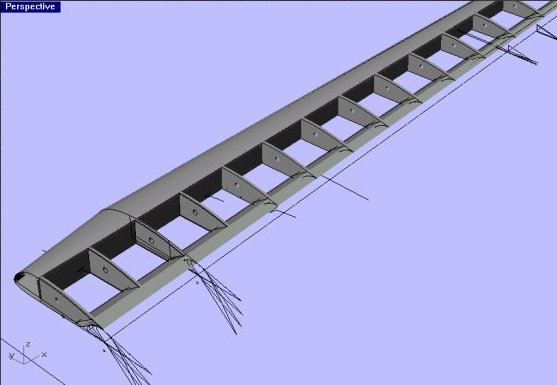
Simplified view of wing...
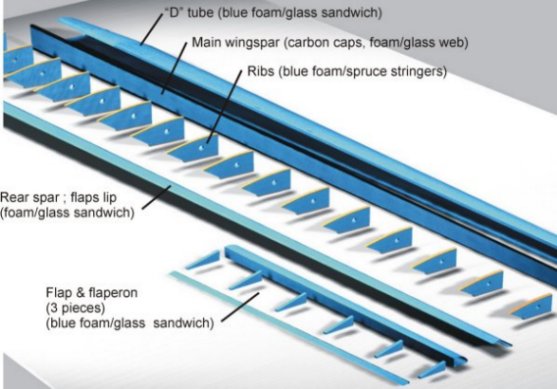
Main wing components (exploded view)
To achieve safety, handling
and performance goals I decided so:
- The max wingspan should not exceed 11m (for
ground handling reasons)
- The wing will have full span slotted flaps with
short lip and close to 40% of chord (for lift coefficient about 2,8)
- Flaps will be spanvise separated in three pieces
(wing flexibility at flaps deployed reason). The outer piece will operate
as flaperon.
- Down motion of aileron, wil be reduced to zero
at full flaps to avoid unwilling stalling of wing tip
- The wing will have two spars, one at end of
torsion nose and other near flap slot. Spar caps will be of prefabricated
ready to use commercially available graphite rods
- Torsion nose will be of sandwich construction
with incorporated front spar, but part between two spars will be made with
ribs and covered with lightweight fabric.
- Rear part of wing (flaps slot) will be of
moldless foam and composite construction incorporated with rear spar.
- Flaps nose will be of foam and composite
moldless construction, making stiff torsion box, the rest of flaperon will
be with ribs and covered with lightweight fabric.
- During flight, the flaps will be driven via
electromotor driven threaded rood, controlled with simple buttons in
cockpit (preffered on one of control sticks) The motor unit will be small
model aircraft motor with apropriate reduction gear and small yet powerful
NI-Cad battery pack. On starting place will be also a possibility to
manually prepare the flaps in down position.
- The wing will be of cantilever design (or maybe
with short wing strut, to solve complexity and stress at wing fuselage
joint).
- The wingtips wil be short sabre alike, but they
can be deassembled and replaced with any type of tip including small
winglets.
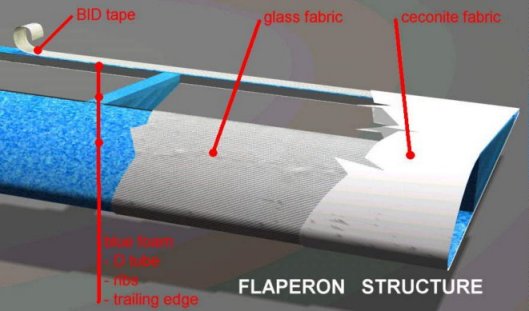
TAIL SURFACES
HORIZONTAL TAIL
- Horizontal tail is almost conventional with
stabilisator and elevator.
- Stabilisator is relatively small and is made as
foam/composite moldless construction.
- The elevator is structural similar to flaps and
is partly aerodynamical and mass balanced.
- The horizontal tail is deatachable and is
mounted in the fin slot and secured with one pin.
VERTICAL TAIL
- The fin is structural part of rear fuselage and
is of foam/composite moldless construction.
- The rudder is is structural similar to elevator
and is partly aerodynamically balanced.
FUSELAGE
- Fuselage is made of 3 small main parts that are
later structurally assembled.
They are as follows:
1. cockpit area with nose cone and two cockpit
sidewalls
2. central part with two main bulkheads and wing
attachment points
3. tail
cone with rudder fin
- The fuselage is build as foam/composite moldless
construction
- Canopy is made of thin free blown plexi and is
mounted on the wide composite frame, which can be sliding forward for
entering in the cockpit.
- Bottom part of the cockpit area is open for the
pilots legs. For the running down the slope there is enough space
available not to disturb normal running.
- The openning at the bottomius closable in
flight, and this is achieved by fabric cover with some stringers for
stiffening and better contour.
- Pilot is atached to the glider with harnes
similar to the early paragliders and is hanging from main fuselage
bulkhead. Pilot also wear shoulder straps for rising the glider on the
ground until the lift pull the sailplane up.
- Flihgt controlls ate of two short controll
sticks placed in left and right close to the sidewall of cockpit area.
- The balistic recovery system is placed between
fuselage bulkheads and is aiming rear and up toward the fin.
- The strange or futuristic shape of fuselage is
not only atractive but also allow to pilot great visibility during start
and flight, and most of all protect the pilot (his legs and back) in case
of crash at start or landing.
- In front, just behind the nosecone, the
sailplane is equipped with short skid and small wheel, and at rear below
the tail there is a short skid too. With this parts the glider can be
pushed around without need to rise it from the ground at all.
- The tail skid also support tail of the sailplane
during take of and preventing the wing to achieve to big angle of attack.
- The landing will be done simply by belly landing
(on the skids and wheel) with pilot in sitting position.
-WHY ARE THE FLAPS DIVIDED
IN 3 PIECES?
Because the wing will
defenetly be bend up during flight, the invisible »hinge line« of flaps wil be
distort from ideal straight line to some kind of arc. If flaps were hinged say
3 times per halfspan, it will be hard to rotate flaps (midle hinge not in line
with outer ones), and flaps will be stressed much more, because it should be
bend at unpleasant direction. At flap retracted it will bend at same manner as
main wing, but at deployed flap it looks that trailing edge of the flap will be
stressed in tension, and will probably break. This hinge missaligment would
probably cause some extra friction in hinges thus rising the command forces to
operate flap…Carbon Dragoon fight this with differential drive 1:4 (+4/-16 if I
remember right)
If we take a piece of paper,
and bend it at long edge (performing simplified shape of wing with deployed
flap) we soon discover that if trying to bend the wing, the bended part- flap,
will take almost all bending load. I dont want to flap take any necessary load
in my design.
So, if I divide flap into 3
parts per halfspan and hinging each part only twice (with ball bearings) I
avoid almost all unwilling stresses of the flap, regarding any wing bending (in
aeroelastic range of operation). Well, the gaps between flaps panels will
decrease their effectivines to some degree, but the gap can be filled with some
kind of foamy material, to avoid air leaking..
-WHY ONLY OUTER PART OF FLAP
ACT AS FLAPERON?
The simpliest way (for
calculations and aso for manufacturing reasons) is to use so called flaperons
on wing for both function (high lift device + controll over bank angle) as is
done at Carbon Dragon.
But I prefferd to divide
them into 3 parts and to use inboard two sections to act as flaps and outer one
as flaperon. Why?
If we imagine ourself just
prepared on the hill for launching, we want to have all benefits
of our high lift device. So, any change of flap(eron) setting toward up, wil
cause less lift. But we want all lift we can get from the wing at such low
speeds during starting phase. If we must rise or lower the tip of wing (if
sudden gust on start put the wing out of level attitude) we must produce a roll
moment over centerline of sailplane. This is simply done by changing the lift
force on wings. But the same moment we get if we produce big force somwhere at
mid span, or much smaller force at the verry outboard part of wing.
I decided to use smaller
force at the tip part of the wing, so there are placed ailerons. They are
flaperons, because mechanically they follow the general motion of two inboart
parts of flaps.
Because wing is already at
high angle of attack (stil talking about take of phase) and almost the
highest CL, the ailerons in this case should move up only. In flap retracted
case, (talking about normal flying) ailerons attain full up and down
motion - diferential of course to fight adwerse yaw.
The mechanical device is not
yet taken in concern because I think it is possible to design such mechanism
and it is now out of scope of this discusion and at present design stage. But
will be soon actual…
With this arangement my wing
will loose minimal of lift force during aileron operation.
REM:I am afraid that long chord flaperons over full span when
deployed and then additionnaly deployed down (and on other wing up) for roll
motion, will produce big controll forces and troubles balancing and overcoming
them…
-ABOUT RUDDER CONTROLL
During my past 22 years of
hang gliding I saw a lot of bad startings and many of them was when some gust
push one wing up, and then glider tend to make circle and hit back to the hill.
If pilot act too slow there is a danger, and also if pilot sudden »pull up« the
high wing gets into stall and we are again back rotating toward the hill. Here
I believe that prompt and exact respond of the pilot is crusial, and also the
respond of sailplane to pilots controlls…
So, I think that all
controlls should be »under controll« during take off to allow the pilot to
instantly correct any deviation from planned motion of the craft. Well,
sailplane is maybe of enough stability around all axes, but we can not controll
nature of the wind over the microlocation of starting place.
Because pilots legs are too
busy runnung at this point, the ruder pedals are free. They are forced into
center position via bungee cords or springs. But in the same time they are
connected with side stick mounted at left side of cockpit, so any action to
rudder is available instantly. Because the ruder is aerodynamically balanced,
the stick forces should not be to big. When pilot retract his legs into
cockpit, they can take over ruder pedals, and side stick is not necessary to
use anymore.
REM: a pilot is
responsibile for the safety of his flight and on him is to choose the weather
situation apropriate for his glider type and his piloting skilss and of course
the type of flying he intend to do. If he made a bad decision, even fine plane
can act as bad and leed to disaster.
ABOUT ANGLE OF ATTACK AT
START
In my previous writting I
mentioned that it is not important to controll the wing angle of attack…(I
claim this only for my design and not for general at all) Well, in my
configuration the pilot is really free of concernig about the angle of attack
during start phase, because the design of fuselage take this responsibility. As
one of my sketches show, the pilot in the cockpit is unable to produce higher
angle of attack that his legs and tail resting on the ground allow.
As we remember from
aerodynamical basics, the angle of attack is angle between direction of
relative wind and airfoil chord line. In starting phase of foot launched
sailplane (or any hang glider) the direction of relative wind is almost paralel
to ground where pilot take run, so angle of attack is stable and guaranteed,
until sailplane take off ground…then we fly, and angle of attack (speed) is
pilot responsibility..
REM: I doubt about
effectivines of elevator because of downwash produced by flaps…?!? L ! Still loot
of required thinking about tail volume, location, deflections, airfoil..ooh!
..oh!!
ABOUT MOLDLESS
FOAM/COMPOSITE CONSTRUCTION
It is possible to make
structural parts enough lightweight, I think…
First, I say bye bye to the
laminar flow around fuselage. If we want laminar flow ower fuselage, then
shape must be totaly diferent than my design. In moldless construction one
should achieve exact shape and streamlining without wavines, by filling,
sanding, filling, sanding, filling, sanding, filling, sanding, .. and this is
one of reasons for heavier structural parts. The wing in this building
technique (Windrose, Rutans designs,…) is generally heavy because the foam core
represent almost 1/3 of total wing weight…In my case I design hollow fuselage
with inner and outer skin. Outer skin should get only such quantity of filler
and micro to cover the weavines of the outer glass fabric ply and I will not
bother with some shape waviness that will cause early flow separation on high
performance sailplanes. We will just let them alone were they are. Let just
take care, that outer skin look straight and smooth for average eye…we not
intend to competite for best finish prize at one of famous Fly-Ins…we aim for
pure strenght and lightweight…
The fuselage core will be
reinforced with stringers of graphite (tape or rods..) and few bulkheads.
ABOUT THE FLAP DRIVE
I imagine, that flaps would
be deployed only before start and at landing. It will be better (safer) for
pilot to land on skid and sitting inside cockpit. It will be possible also to
land with flaps in zero position. If we estimate wing loading of 13 kg/m2 and CL max =1,6 of pure
airfoil, we can expect the stall speed about 40 km/h what is enough low even to
land safely with this (flight) confuiguration.
The question is only how
to reduce glide angle on final if field is short and it is to late to deploy
flaps. I dont like to put glider into slip close to the ground…it give me
strange uncorfotable feelings…Spoilers I dont like to put on the glider-one
more control system and added weight…
Any solution,
suggestion?
I
choose electrical driven flaps simply because In my case, they wil serve only
at start and at landing. Maybe some of the flaps will be needed during some
thermal circling..
I think
that one battery (usually used for electrical driven model airplanes, say 2000
mAh and 150W cheap can motor, with homemade gears) can serve during flight and
landing demands. Before start, when preparing the sailplane for flight, pilot
can mannually drive mechanism to flaps be deployed, and save some battery power
for later (in flight) use. The battery can be easily recharged with use of charger and
automotive battery in short time, when preparing for next flight…
